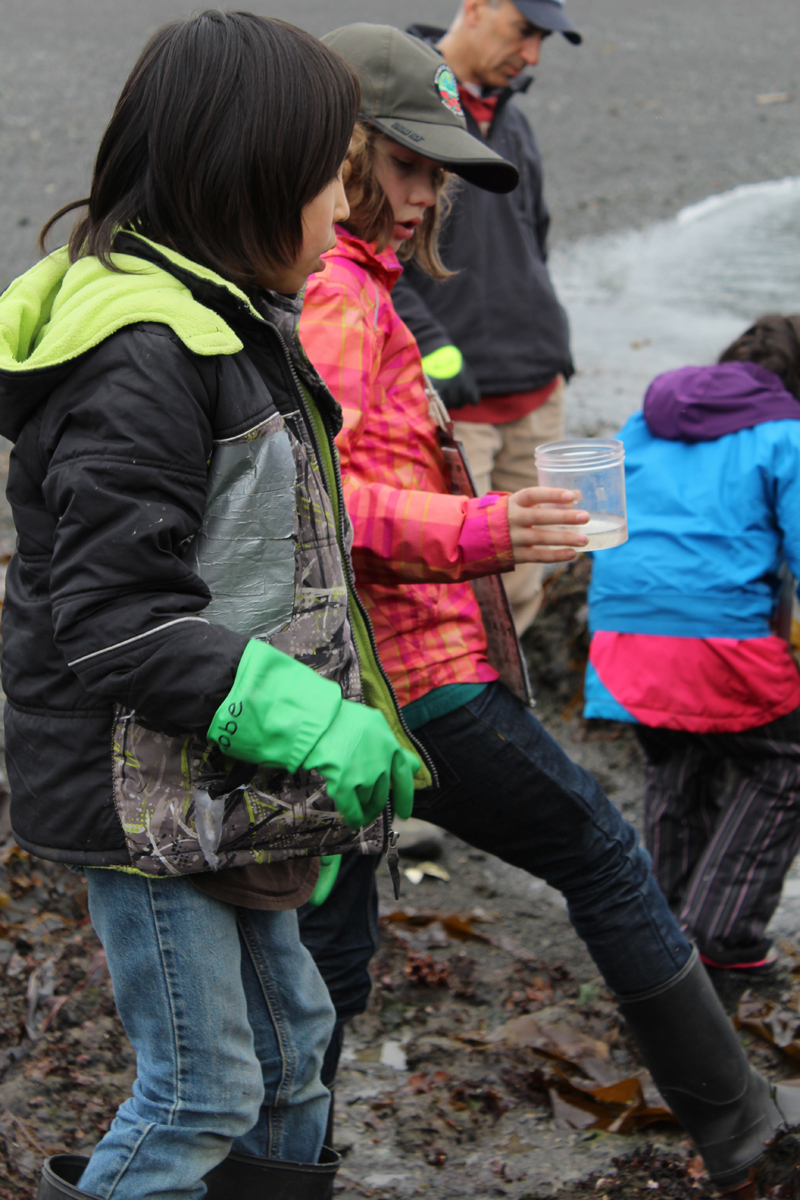“Disco!” yells an excited boy standing on top of a cluster of rocks on Otter Rock. The rest of the group comprised of fourth, fifth, and sixth graders and two naturalists look up from the tide pools and start moving towards him.
‘Disco,’ short for discovery, alerts the group visiting the Center for Alaskan Coastal Studies Peterson Bay Field Station that a new creature has been found. In this case, the group looked at a sea cucumber as Peterson Bay Field Station naturalist Caitlin Lenahan explained the creature’s habits and unique features to the children.
It is here on Otter Rock that the children in Soldotna Montessori teacher Terri Carter’s class – and thousands of others before them – learn the about nature’s wonders and the importance of conservation.
The trip is the culmination of a six-week unit in Carter’s mixed grade class the
students look forward to all year long, Carter said. The sixth graders are returning for their third and final time, the fifth graders have come once before and the fourth graders are discovering Peterson Bay’s creatures for the first time. The older children mentor their younger classmates, and the naturalists and parent chaperones ensure the children don’t disturb the tide pools in all their excitement.
Carter has been taking her classes to Peterson Bay Field Station since 1998, sometimes going multiple times each year. The learning that takes place on the field trip makes the things she teaches real to them, Carter said.
“When kids get to learn something in theory in classroom its powerful but when they get to apply it in reality, its empowering,” Carter said. “They get from knowing it intellectually to knowing it relationally.”
When the group goes out to the tide pools, the naturalists give the kids a laminated chart of the creatures they might see to wear around their necks. This way, they can identify organisms for themselves and help the naturalists keep track of the sea life on Otter Rock. Once back at the field station, they list everything they saw by phylum such as Arthropoda, Mollusca, Echinodermata, and Cnidaria. Each child eagerly rattled off the creatures they had identified, from decorator crabs to a giant pacific octopus.
CACS gave its first educational outing for the Homer Community to China Poot Bay in 1981; the following year, the non-profit began leasing the Peterson Bay property, according to CACS. After volunteers completed the building and the trail system, the first overnight school field trip at the field station’s wilderness lodge hosted 76 Homer fourth graders in 1983. Educational programs for spring school groups and summer nature tours began in 1984. The field station has added on new programs through partnerships with organizations like NOAA Kasitsna Bay lab and Kachemak Bay Conservation Society. However, the lessons learned there remain the same and the memories made by visiting children are lifelong ones.
“I have kids come back and see me and … they remember the time on the beach and finding rare things and experiencing the beauty of nature at its finest,” Carter said. “To be on the beach and squeal with delight is worth its weight in gold. The Center for Alaskan Coastal Studies has been doing that so heroically. Thousands of kids have gone through it who have been transformed and informed because of it.”
Conversation of Alaskan wilderness is a passion of Carter’s, a Soldotna native who saw the landscape of the Kenai River change in a few short decades. Over time, people without lifelong investment in the area changed the nature she once knew as home.
“There was so much salmon it seemed eternal and in the course of my life, look at how its been depleted. All the people who come from elsewhere and they plan to return to elsewhere, just like the fur traders and gold miners, they’re here to make their fortunes and go back. But the kids, this is their place seeing the explosions of development of the temporary and transient people,” Carter said.
Helping the children she teaches see the true value of places like Otter Rock, value that can’t be measured in money, will protect other places from development in the future, Carter said.
“I can’t go back and change what’s been done, but I can impact the future by impacting these kids and helping them to see. We protect what we love and those kids walk away after three years absolutely loving that place,” Carter said. “I have no doubt that those kids will be key decision makers that will advocates for wildlife. They know that we don’t inherit it from our grandparents; we borrow it from our grandchildren.”
Anna Frost can be reached at anna.frost@homernews.com.


